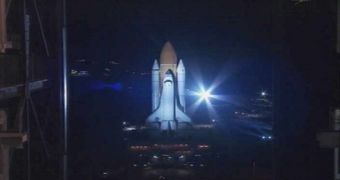Last night, Monday (January 31), the space shuttle Discovery was returned to its launch facility in Florida, after spending more than a month in a NASA hangar for repairs. The mission is now due to take off to low-Earth orbit on February 24.
This was the second time that the spacecraft, its external fuel tank, and its twin solid rocket boosters (SRB) were loaded onto the Crawler Transporter, and rolled out of a NASA assembly facility.
They were bound for Launch Pad 39A, the only one left operational following the handing over of the other facility, Launch Pad 39B, to Project Constellation. Both pads are located at the Kennedy Space Center (KSC), in Florida.
LP-39A is the only facility in the United States that can support shuttle launches. Discovery is long overdue to the International Space Station (ISS), where it should have arrived in early November 2010.
But the launch data continuously slipped further and further, primarily due to damages found in the shuttle and on its external fuel tank. In late December 2010, the damage was deemed so severe that NASA officials decided to roll the orbiter back from the pad.
It was therefore again taken to the cavernous KSC Vehicle Assembly Building (VAB), where engineers performed rigorous X-ray tests on the shuttle and its external components. This allowed them to find additional damage and fix it.
Finally, earlier this month, NASA officials announced that Discovery was finally ready to roll out again. The maneuver took place last night, and saw the agency's oldest shuttle carry out its last 6-hour trek to the LP-39A facility, Space reports.
“It's very exciting. I'm not focusing too much on it being the last one again, I'm just enjoying the fact that we've overcome a huge challenge,” explains NASA official Stephanie Stilson.
“The team has worked really hard to get us to the point where we're able to get back out to the launch pad […] It's a beautiful sight,” Stilson adds. She is the vehicle flow manager for this shuttle at NASA.
The rollout maneuvers began at around 7:58 pm EST (0058 GMT February 1), as the orbiter was placed vertically on its Transporter, the second-largest tracked vehicle in the world. The machine is capable of carrying its massive load at an average speed of around 1 mile per hour.
Current plans to launch Discovery to the ISS call for it to take off at 4:50 pm EST (2150 GMT), on February 24. It is carrying a Multipurpose Logistics Module (MPLM) cargo container to the ISS, as well as the Robonaut 2, a robotic astronaut developed by NASA and General Motors.
“It feels really good. It feels like we're back to where we need to be. It's been a challenging several months for the team, but it's also been very rewarding doing what we need to do and making sure Discovery flies safe and that we're doing everything right,” Stilson explains.
“We want to make sure we're able to be successful and go down in history on a positive note,” she concludes.

 14 DAY TRIAL //
14 DAY TRIAL //